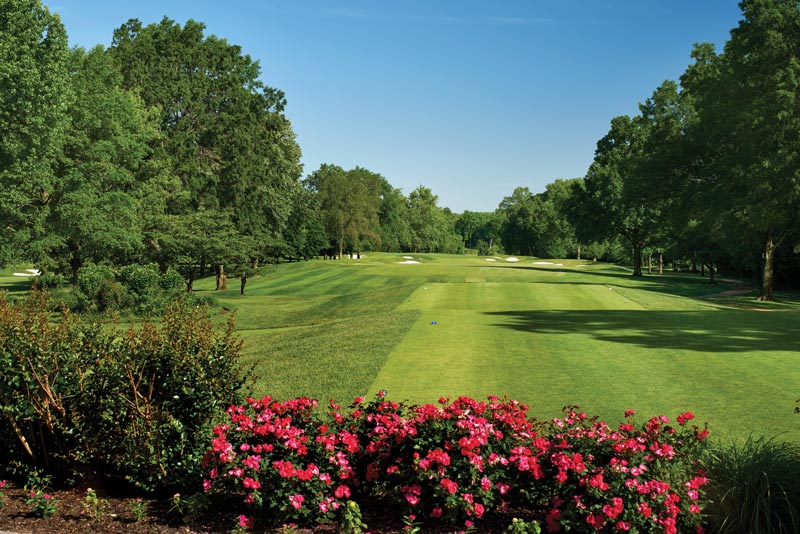
Bellerive Country Club in St. Louis. Photo by David Torrence
Meyer zoysiagrass graces the fairways and tees at Bellerive Country Club in St. Louis, where this month’s PGA Championship will be contested. Meyer zoysia was released jointly by the U.S. Department of Agriculture (USDA) and the USGA in 1952. Few turfgrasses that were used in 1952 are still being used today.
There is an interesting story behind the arrival of Meyer zoysia in the U.S. It starts with George Fairchild, who served as the third president of Kansas State University from 1879 to 1897. George’s son, David, received bachelor’s and master’s degrees in agriculture from Kansas State.
David married Marian Bell, the daughter of Alexander Graham Bell, inventor of the telephone. The Bell companies (Southwestern Bell, Pacific Bell, etc.) were the predecessors to AT&T. It appears David had solidified his retirement package even before beginning work. After finishing his master’s and completing further study at Iowa State University, David was hired by the USDA as a plant explorer, and eventually headed the Office of Seed and Plant Introduction.
David Fairchild sought to employ a plant explorer who had the ability to walk long distances, and he hired Frank Meyer, who was originally from the Netherlands. Meyer was one of the first from the USDA to explore Asia.
Travel options were limited to foot, boat and horseback. Meyer didn’t search just for grasses, as the USDA was interested in bringing a plethora of plants to the U.S., including food crops and ornamentals. Meyer’s first expedition to the Far East took place from 1905 to 1908, and he took three similar trips between 1909 and 1918.
Palemon Dorsett and William Morse followed Meyer with an extensive plant exploration trip to Asia between 1929 and 1932. Although the primary focus of their trip was the collection of soybeans, they collected seed from grasses, including zoysia. Meyer zoysia seed was apparently collected on this trip in Kanggye, North Korea. The seed was returned to Arlington Turf Gardens near Washington, D.C., now home of the Pentagon.
There’s irony here: Seed that was collected in North Korea was brought to the U.S. and evaluated in the field at the same site where the headquarters of the U.S. Department of Defense now sits. The top performer among the grasses evaluated was later named Meyer, in honor of Frank Meyer’s early efforts in plant exploration.
The grass has been used as a vegetatively propagated zoysia cultivar since its 1952 release, which was overseen by the late Fred V. Grau, Ph.D., an acclaimed scientist with the USGA.
In 1967, Mel Anderson, a 57-year retired member of GCSAA who is now 85, became a pioneer in his own right when he decided to sprig Meyer zoysia at Alvamar Hills Golf Course, an 18-hole public course in Lawrence, Kan. (It later became Alvamar Country Club, a 36-hole public/private facility, and most recently became a 27-hole facility, The Jayhawk Club).
Alvamar was the first golf course in the U.S. to establish Meyer from its inception. Following Anderson’s efforts, Meyer was quickly recognized as an excellent turf for fairways and tees in the transition zone climate. It’s tolerant to heat and cold, maintains excellent density with limited inputs of fertilizer and pesticides, and requires less mowing and water compared with cool-season grasses. This month, Anderson will be inducted into the Kansas Golf Hall of Fame.
GCM readers will see green grass at the PGA Championship at Bellerive, and now you know the arduous travel (Fairchild, Meyer, Dorsett, Morse), genius of plant selection (Grau) and courage of a forward-thinking superintendent (Anderson) that were required to deliver the grass that provides those championship-level fairways and tees.
Note: Some of the information in the bios for these gentlemen was collected from PlantExplorers.com and Wikipedia. Thanks go to Dick Stuntz, CGCS, president of Oak Golf, for reviewing.
Jack Fry, Ph.D., is a professor of turfgrass science at Kansas State University’s Olathe Horticulture Research and Extension Center in Olathe, Kan.